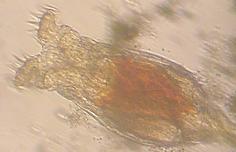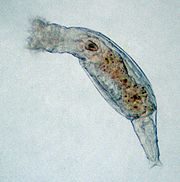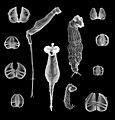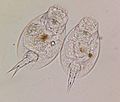Rotifer facts for kids
The rotifers are tiny animals that live mostly in freshwater environments, like ponds and puddles. Some rotifers swim freely, others move by wiggling along, and some stay in one place. A few types even live together in groups called colonies.
Quick facts for kids Rotifera |
|
|---|---|
| Scientific classification | |
| Domain: | |
| Kingdom: | |
| Subkingdom: | |
| Superphylum: | |
| Phylum: |
Rotifera
Cuvier, 1798
|
| Classes | |
|
Monogononta, Bdelloidea, Seisonidea |
|
Contents
What are Rotifers?
Rotifers were first discovered around the year 1700 when early microscopes became available. They are a very important part of the tiny living things in freshwater, called zooplankton. Many rotifer species also help break down dead plants and animals in soil.
Rotifers eat things like fish waste, dead bacteria, and tiny algae. They can eat particles up to 10 micrometres in size, which is super tiny! A rotifer can filter 100,000 times its own body size in water every hour. Because they are so good at cleaning water, rotifers are sometimes used in fish tanks to help keep the water clear.
Types of Rotifers
Scientists have found and described about 2,200 different species of rotifers. They all belong to a larger group called the phylum Rotifera. This phylum is divided into three main groups, or classes: Monogononta, Bdelloidea, and Seisonidea.
The biggest group is the Monogononta, with about 1,500 species. The Bdelloidea group has about 350 species. The Seisonidea group is much smaller, with only two known species.
Scientists have found very old rotifer fossils. Some fossils of a species called Habrotrocha angusticollis were found in peat deposits that are 6,000 years old. Even older rotifer fossils have been found preserved in amber, which is fossilized tree sap.
How Do Rotifers Look?
The front part of a rotifer has a special ring of tiny hairs called cilia that circle its mouth. These cilia move very fast, making it look like a spinning wheel. This is why rotifers used to be called "wheel animalcules."
Most rotifers have a protective outer shell called a lorica around their body, and a foot that helps them attach or move. Inside their tiny bodies, they have all the usual organs, just in miniature! These include a brain, an eye-spot (to sense light), jaws, a stomach, kidneys, and a bladder.
Rotifers have some very unique features. Scientists believe these special traits help them survive in their small and often changing homes, especially when water dries up.
How Rotifers Survive Dryness
Rotifers are amazing at living in places where the water often dries up. They have special ways to survive long periods without water.
The Monogononta group, which has both males and females, produces special 'resting eggs'. These eggs are fertilized and can survive being completely dry for a very long time.
The Bdelloid rotifers, which are all female, have a different trick. When their water dries up, they can curl into a tiny, inactive ball and lose almost all the water from their bodies. This process is called cryptobiosis. Bdelloids can stay in this dry state for many years. The longest time recorded is nine years! When water is added back, they can "wake up" and become active again. This ability makes them a truly unique group of animals.
Rotifer Cell Structure
Rotifers are born with a set number of cell nuclei, and this number is exactly the same for every rotifer of the same species. This special feature is called eutely. Once they are adults, their cells do not divide anymore. Not only that, but the number of nuclei in each body part is also constant. Many of their nuclei do not have cell walls, meaning their body tissue is often like one big cell with many nuclei, called a syncytium.
Surviving Radiation
Because their cells don't divide once they are adults, rotifers are incredibly resistant to harmful radiation. Also, they are known to be very good at repairing their DNA after they have been dried out and then rehydrated.
Bdelloid Rotifers: All Female?
In the Bdelloid rotifer group, scientists have never seen any males. This makes them the largest group of animals that reproduce only through parthenogenesis, which means "virgin birth."
The females in this group produce eggs without needing a male. In some species, these eggs even develop into small baby rotifers before they leave their mother. These offspring are exact copies, or clones, of their mother.
Studies show that bdelloids have been reproducing this way for a very long time, possibly for about 100 million years! They lost the ability to mix genes through sexual reproduction (like meiosis and fertilization) a long time ago.
Bdelloid Genetics
Bdelloid rotifers have an interesting genetic makeup. Their genomes contain two or more different copies of each gene. This is unusual and suggests their asexual reproduction has been going on for a very long time. For example, they have four different copies of a gene called hsp82, and each copy is on a different chromosome. This is different from how genes usually duplicate.
Even more surprisingly, bdelloid rotifers have genes that seem to have come from bacteria, fungi, and plants. This means they have picked up genes from other types of living things through something called horizontal gene transfer (HGT). It seems that taking and using these "foreign" genes is important for how bdelloids have changed over time. Scientists have found that bdelloid rotifers have about 8% of their genes from bacterial origins, which is a record for animals!
Acanthocephala: Related Worms
The Acanthocephala are a group of parasitic worms. They used to be considered a completely separate group of animals. However, recent studies have shown that they are actually modified rotifers! Scientists are still working to figure out their exact relationship to the normal, free-living rotifers.
Rotifer Websites
- Microscopy UK Gallery of Rotifers [1]
- Live birth [2]
- Micrographia.com Rotifer guide [3]
- Wheelbase [4]
Images for kids
See also
 In Spanish: Rotifera para niños
In Spanish: Rotifera para niños








